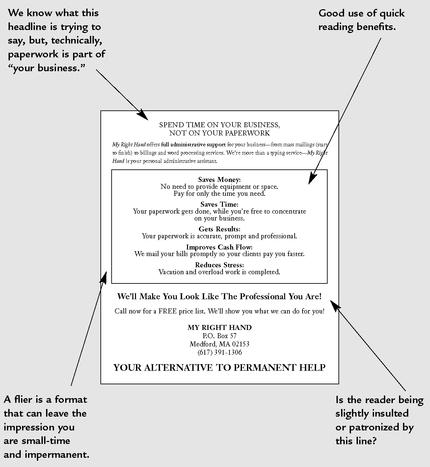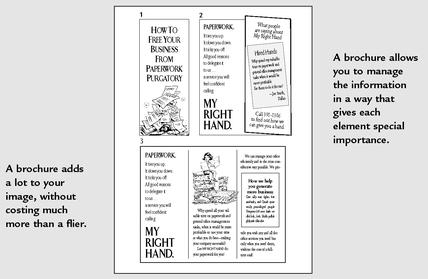Read Start Your Own Business Online
Authors: Inc The Staff of Entrepreneur Media
Start Your Own Business (82 page)
A list will typically be provided in an electronic format or on pre-printed mailing labels and sent directly to the vendor you want to do the final mailing. Consider using a mailing house. Mailing houses have the equipment to professionally cut and apply preprinted labels or to download electronic files and rapidly create and affix labels by the thousands to your envelopes. A large mailing house can also personalize and print your letter and envelope, handle the folding and insertion and do everything else associated with assembling your direct-mail package. Depending on the level of service you need, rates may range from a few hundred to several thousand dollars for a 5,000-piece mailing.
Most experts agree renting fewer than 5,000 names isn’t worthwhile, primarily because a large mailing doesn’t cost much more per piece than a small mailing, and the returns are higher. Start with about 5,000 names for your first mailing, and consider it a test.
Entrepreneurs inexperienced with direct mail are often surprised to learn that the average positive response rate is between 2 and 3 percent. In some industries or with some types of products and services, a 1 percent response rate may be considered positive. If you believe your responses are less than stellar, it may be that the market isn’t right for your product, your mailer isn’t attention-grabbing enough, or your prices are too high. If you get a response of 2 percent or higher, then you’re on the right track.
Once you develop a complete mailer, continue to test your enclosures by adding or eliminating one important element at a time and keeping track of any upward or downward changes in response.
BrochuresFor many businesses, especially service companies, a brochure is the building block of all marketing materials. A brochure is an information piece that doubles as an image maker. The look and feel of the brochure don’t only describe the benefits of your product or service, but also convey your legitimacy and professionalism. A brochure can make your small company look just as substantial as a more established rival, making it a great equalizer.
The good news is that a brochure doesn’t have to be expensive. It can be almost as cheap to produce as a flier. A brochure can be as uncomplicated as a piece of folded paper—the same piece of letter-sized paper that would otherwise be a flier. By folding it twice, as you would a letter, then turning it upright so it opens like a book, you have the basis for a brochure.
The magic of the brochure format is that it allows for a more dramatic presentation of the material than does a flier. Think of your brochure cover as the stage curtain, creating anticipation of the excitement that lies inside. An eye-catching headline on the cover is like the master of ceremonies, piquing the prospect’s interest about what’s behind the “curtain.” Inside, you first need to pay off the promise, or claim, in the cover headline with another headline, then use the remaining space for elaboration.
SAVEGo to direct-mail school in your mailbox. Each day your mail brings a handful of direct-mail solicitations you can use for hands-on education. Study the letters, use design ideas from the fliers, and keep copies of different types of reply cards. Big-time direct-mail companies spend millions refining their mailing techniques. You can use that information just for the price of tearing open the envelope.
The principles of writing successful brochures are basically the same as those for writing print ads (see the “Print Advertising” section starting on page 502). However, brochures offer more room than ads, so there is a tendency to get long-winded and wordy. Keep your brochure brief, with enough information to interest readers but not so much repetition that they get bored. Use benefit-laden headlines and subheads, and “explain” your benefits by detailing all your features in the body copy.
The sample on page 522 shows a “before and after” makeover of a brochure for a company called My Right Hand that provides business support services. The first step in boosting this brochure’s appeal was coming up with a tempting headline for the cover. The goal is to arouse the interest of potential clients—the harried sole proprietor who needs help with the detailed paperwork involved in running a business alone. The revised headline “How To Free Your Business From Paperwork Purgatory” accomplishes that goal.
In this or any other headline, it’s important to go beyond the ordinary. Give your headline an unexpected word or phrase that expresses the idea in a memorable fashion. Adding the word “purgatory” gives this headline extra drama and emotion and puts the worst face on paperwork.
When the prospect flips the page, he or she finds a short-storylength headline that builds on the cover: “PAPERWORK. It ties you up. It slows you down. It ticks you off. All good reasons to delegate it to us ... a service you’ll feel confident calling MY RIGHT HAND.”
This headline pushes the prospect’s buttons (i.e., sensitivities) by emphasizing that paperwork is a grind, a bore and a frustration. The buzzword “delegate” is used because delegation is recognized as essential to entrepreneurial success when a business has grown too big for one person to handle. And since confidence and trust are essential when giving your business papers to an unknown company, the headline also emphasizes the company’s trustworthiness by using the word “confident.”
The overall look of a brochure is the key to making a good impression on prospective customers. Here are some tips to make sure yours is inviting to the eye:
• Have the descriptive copy typeset in a fairly large size. There’s no bigger turnoff for a prospect than squinting at tiny printing.
• Use light-colored paper. This, too, makes the brochure easier to read.
• Break up the copy with subheads. This makes the overall brochure less intimidating to read.
• Add something unexpected visually. One idea is to use a striking photo or graphic on the cover.
• Use the back of your brochure for a “business biography.” This is a good place to talk about how your company got started, how it has succeeded and where it is today.
• Always use endorsements, testimonials, industry affiliations or other credibility-raising elements.
• Spend a little extra money. It’s worth it to have your brochure printed on cover stock or quality heavyweight paper. A key part of the impression it makes is the way it feels in the customer’s hand.
TIPEven if you do most of your business by mail or over the phone, customers like to see who they’re doing business with. Put your photo on your brochures or mailings. It conveys friendliness and builds confidence in your company.
Whether you send it out solo or as part of a direct-mail package (see “Package Deal” on page 538), a sales letter can be one of your most effective marketing tools, allowing you to speak one-on-one to prospects and customers. What makes a good sales letter? There are three key rules:
Sample BrochureBEFORE
: The flier format, while imparting the basic message, is a bit “downscale” for a somewhat sophisticated service.AFTER
: A brochure gives you a more polished image. It says you are seasoned, sophisticated, professional.
1.
Start with a hook
. Begin your letter with a provocative thought or idea that hooks readers and makes them want to keep reading.
2.
Give them the facts fast
. Quickly list the top two or three benefits of doing business with your company.
3.
End persuasively
. Close the letter with a strong argument that compels readers to respond.
How long should a sales letter be? The standard answer is “long enough to do the job.” And yes, it takes longer to persuade a prospective customer to buy than to merely get him to inquire further. But in today’s high-tech age, people become impatient with anything that takes much longer than an eyeblink to read.
TIPTrial sizes and sampling work. Have employees pass out product samples in front of your store; if you provide a service, offer a free trial period or consultation.
Other books
Reign of the Vampires by Rebekah R. Ganiere
The Swan Kingdom by Zoe Marriott
Taken by Two Bikers by Jasmine Black
Hunger (The Hunger Series Book 1) by Jeremiah Knight
The Sign by Khoury, Raymond
Reawakening the Dragon: Part Two by Jessie Donovan
Cross of Fire by Forbes, Colin
Hollywood Babilonia by Kenneth Anger
Contagious by Scott Sigler






